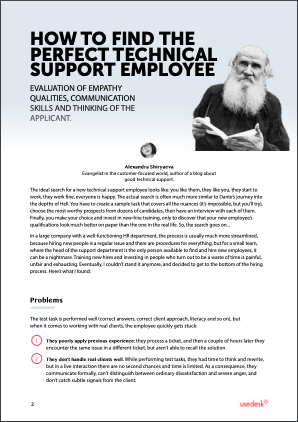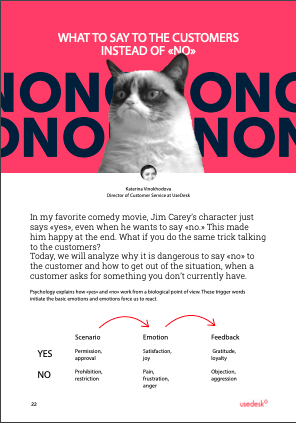Request a Demo
Send us a request for an online demonstration at the time that's convenient for you. We will give you an overview and answer any questions you may have about the system.
By clicking the button, you agree that you have read our Privacy Policy
Instruction: how to support work with different types of clients
Part 2
To different clients — a different approach, but this does not mean that each client is unique. Most likely, it can be attributed to some type. If you recognize the character of the client, then consider this already 50% of successful communication.
In the first part of the article, I examined 5 types of customers: how to recognize and communicate with them.
Today we'll take a look at the other 6.
Imaginary VIP client
The client considers himself unique, mentions acquaintances with influential people, and refers to a large audience of followers. He may threaten that he will tell everyone about you in his channel on the Telegram, which is not there or is not as popular as he says.
Katerina Vinokhodova
Usedesk co-founder
Signs
If a customer claims to be special, check their status. Perhaps he really is VIP. Then proceed as in the case of a real VIP. If he lied, there is no need to tell the client that he is not too VIP for you, work as with an ordinary client — carefully and attentively.
He requires a particular attitude and frightens his acquaintances.
How to work with him
Bad
Good
— My nephew is an employee of the National Guard!
— Yes, even if the president, it does not affect the terms of our agreement with you!
— Yes, even if the president, it does not affect the terms of our agreement with you!


— My nephew is an employee of the National Guard!
— Let me advise you in detail and together we will figure out the terms of the contract ...
— Let me advise you in detail and together we will figure out the terms of the contract ...
Real VIP client
Usually, customers who need special treatment are marked in CRM, but this does not always work. If you see from the history of interactions that the customer buys only the most expensive, makes frequent purchases, or has been with you since 2001, this is a hidden VIP. Be sure to note in CRM why the client is particular and some recommendations on communicating with him.
Signs
Do not be greedy for bonuses, because they will be more than paid off with purchases. Look for a personal touch and forget about templates. Be attentive to everything you say and do - double-check it several times; mistakes with such a client are expensive. But if you made a mistake, do not hesitate to apologize and ask for a second chance; promise to improve and correct yourself. If such a client wrote about his page - go to the PM, or rather call to settle the issue personally as quickly as possible.
In cases where the VIP client is wrong, decide how soft or hard - and clearly state your position. In no case, change your position: if you said no, then no. Otherwise, you will show your position's precariousness, self-doubt and only spoil your future relationship - the client will no longer respect you and take you seriously.
In cases where the VIP client is wrong, decide how soft or hard - and clearly state your position. In no case, change your position: if you said no, then no. Otherwise, you will show your position's precariousness, self-doubt and only spoil your future relationship - the client will no longer respect you and take you seriously.
Buys only the most expensive, makes frequent purchases, has been buying from you for many years, has an audience in social networks - it can make you good or bad PR.
How to work with him
Bad
Good
— You see that I have been buying from you for 15 years! Why not give a discount?
— We are very grateful for the attention to our company, but discounts are not provided.
— We are very grateful for the attention to our company, but discounts are not provided.


— You see that I have been buying from you for 15 years! Why not give a discount?
— I agree, our omission. What if we offer you a personalized 10% discount on all items?
— I agree, our omission. What if we offer you a personalized 10% discount on all items?
Forgetful client
A client who addresses a problem and then disappears. You ask him for additional information, without which you cannot solve his pain, but he is silent. A week later, he comes back with displeasure, " I wrote to you, and you never helped me."
Signs
It happens that a client wrote you a complaint, you answered him on the merits, but he did not react in the response. When you have replied but received no feedback, it is always dangerous. It is not clear what the client is going to do next. Perhaps he took offense and went to write a post on Facebook or took a statement to the court.
In such a situation, take the initiative — ask him if he received an answer to his question, whether his problem was resolved. If the problem is critical, sit down on the phone and solve the problem over the phone. If the problem is urgent but not critical, do not hesitate to write to the client once a day; if not urgent, it is enough to write once every three days. Make automatic reminders. So in the event of a trial or a scandal on social networks, you will have proof: you tried to help him, but he refused.
In such a situation, take the initiative — ask him if he received an answer to his question, whether his problem was resolved. If the problem is critical, sit down on the phone and solve the problem over the phone. If the problem is urgent but not critical, do not hesitate to write to the client once a day; if not urgent, it is enough to write once every three days. Make automatic reminders. So in the event of a trial or a scandal on social networks, you will have proof: you tried to help him, but he refused.
Handles the problem and disappears.
How to work with him

The cheating client
Cheaters can be disguised as disgruntled customers. For example, a person rode a rented scooter and crashed it; they took money from him for damaging the scooter. And then, he calls the support service and claims that they took it off illegally; he did not break anything. You can see from all the data that it is his fault.
If you work in a bank or other financial institution, in addition to simple fraudsters, you may encounter fraudsters who contact support under the guise of a client. For example, a person calls and says that he cannot pay for an order with a card. You see that the payment is suspicious, and you understand that it is not the cardholder who is calling. Or you may receive calls from clients who launder money - this can be seen from their account when they regularly deposit and immediately withdraw money.
If you work in a bank or other financial institution, in addition to simple fraudsters, you may encounter fraudsters who contact support under the guise of a client. For example, a person calls and says that he cannot pay for an order with a card. You see that the payment is suspicious, and you understand that it is not the cardholder who is calling. Or you may receive calls from clients who launder money - this can be seen from their account when they regularly deposit and immediately withdraw money.
Signs
Deceivers often say one thing first, then another. If you see that the client is confused in the testimony, contradicts himself, answers your questions "I don't remember," "I forgot," - this is a reason to be wary. Check with colleagues in the neighboring department about the case with this client and figure out what is really going on.
If his lies are confirmed, answer as if you are "in court." Clearly in chronological order, with arguments and legally competently describe what the situation looks like on your part: the contract says so and so, you violated the clause like this, here is a photo, this is the time where you were, such a sum was withdrawn from you property damage account. Show that you saw through him, and he will not deceive you. But first, be sure to make sure that he is a deceiver - do not throw yourself at the client if you are not sure.
If his lies are confirmed, answer as if you are "in court." Clearly in chronological order, with arguments and legally competently describe what the situation looks like on your part: the contract says so and so, you violated the clause like this, here is a photo, this is the time where you were, such a sum was withdrawn from you property damage account. Show that you saw through him, and he will not deceive you. But first, be sure to make sure that he is a deceiver - do not throw yourself at the client if you are not sure.
He makes a complaint but gets confused in his testimony and often answers "I don't remember," "I don't know", to clarifying questions.
How to work with him
Difficult client
A client with a real critical problem that happened through your fault, and now you need to sort out the situation. For example: the client was driving a car-sharing, his brakes failed, and now he is in intensive care; after the arrival of the cleaner, the client discovered the loss of money from the sideboard; the courier beat the client; the taxi driver swore at the client.
The problem may not be related to your service, but the client mentions his trouble in a dialogue with you.
The problem may not be related to your service, but the client mentions his trouble in a dialogue with you.
Signs
Be sure to show empathy, support the client morally. Switch from correspondence to a telephone conversation. Ask what help is needed right now. If the trouble is due to the fault of your service or employee, you need to compensate for losses, pay for treatment, do it - always keep in your piggy bank the amount for such critical cases. Act according to the situation; there are no standard solutions.
The client is in trouble.
How to work with him
Bad
Good
— I need to return tickets; my husband beat me.
— To return, you need ...
— To return, you need ...


— I need to return tickets; my husband beat me.
— Are you okay? I'll arrange everything with tickets now, don't worry. If you need to call the police or an ambulance or help in some other way —let me know!
— Are you okay? I'll arrange everything with tickets now, don't worry. If you need to call the police or an ambulance or help in some other way —let me know!
Loyal client
A client who loves you and tells everyone how good you are. But if you make a mistake once, and problems cannot be avoided. If you do not live up to his expectations one day, he will feel betrayed and will take revenge.
Signs
Be sure to show loyalty in return - give your loyal customer bonuses and other goodies. Be very careful in consultations - double-check the answers and carefully understand the details of his questions. Work with him as a VIP client - send verified couriers, let's take part in testing beta versions of the application, switch to the best operators.
Such clients can be cited as an example for free internal and external PR. For example, tell the rest of the company how customers praise your product, love the support service, and how great you are. And to receive new orders - ask the client for permission to share his review in public.
Such clients can be cited as an example for free internal and external PR. For example, tell the rest of the company how customers praise your product, love the support service, and how great you are. And to receive new orders - ask the client for permission to share his review in public.
The client tells everyone how good you are.
How to work with him
Bad
Good
— Thank you very much for your consultation! By the way, I recommend you all!
— no answer
— no answer


— Thank you very much for your consultation! By the way, I recommend you all!
— So lovely to hear! We are doing our best for you ❤️ Write if you have more questions.
— So lovely to hear! We are doing our best for you ❤️ Write if you have more questions.
Bonus: how to establish contact with any client:
1. Mirror. Use the same vocabulary and tone — always one tone higher. If the client is positive, use emoticons, if sad, empathize and reassure
2. Neutralize. If the client talks a lot, answer shortly, quickly, and to the point. Swearing — respond calmly and kindly — confusing — phrasing answers in a structured way.
3. Join. Let him know that he is right. Team up with him against the problem.
4. Reinforce. If the client shows loyalty to you, he strengthens the excellent impression with bonuses and other goodies.
2. Neutralize. If the client talks a lot, answer shortly, quickly, and to the point. Swearing — respond calmly and kindly — confusing — phrasing answers in a structured way.
3. Join. Let him know that he is right. Team up with him against the problem.
4. Reinforce. If the client shows loyalty to you, he strengthens the excellent impression with bonuses and other goodies.
Share with your colleagues:
Did you like this article?
Error get alias
We know a lot about customer service
Once every two weeks, we will send exciting and valuable materials about customer service - articles, cases, and system updates. Do you mind?







